Research Article - (2023) Volume 7, Issue 2
Growing Results of Baltic Salmon Smolts in Sea Water of Critical Salinity
Garlov PE*,
Bugrimov BS and
Rybalova NB
Department of Marine Biology, Agrarian University, Moscow, Russia
*Correspondence:
Garlov PE, Department of Marine Biology, Agrarian University,
Moscow,
Russia,
Email:
Received: 27-May-2021, Manuscript No. IPJVMS-23-8710;
Editor assigned: 01-Jun-2021, Pre QC No. IPJVMS-23-8710;
Reviewed: 15-Jun-2021, QC No. IPJVMS-23-8710;
Revised: 02-Jun-2023, Manuscript No. IPJVMS-23-8710;
Published:
30-Jun-2023, DOI: 10.36648/2574-2868.7.2.12
Abstract
The strength of the baltic population of Atlantic salmon, salmo salar in our North-western region at present is minimal and is supported mainly by Salmon-Breeding Factories (SBF). Factory producers of origin return is about 2% of the total number of released juveniles, which testifies to its low survival rate and the need to improve the biotech cultivation (Reports of the college of the RF federal fisheries agency for periods 2009-2014). The greatest waste factory juveniles occur in the final stages of the biotechnical production and especially when its release into the natural environment. It is customary to explain its lack of survival in the environment because the degrees of development and growth of juvenile fish in the river factory, reaching smoltification. It is important that the occurrence and extent of the freshwater salmon dwarf males among factory juveniles are much higher than in nature. The mass planting material-weight standard of juveniles shall be not less than 30 grams. However, many salmon fish factories in all or a significant portion of the recruit let out it at a much smaller mass. That often explain by the high planting densities due to lack of outgrown (basin) areas.
In recent years, also abnormally high summer temperature, which violate all links the process of reproduction, forcing emergency order to produce non-growth juveniles (fingerlings) sample 2 g-8 g, forcing SBF to release them near their territories. The problem of obtaining enough major planting of enhanced bio-technique development can solve-intensive growing of juveniles. So, more trout farms in north region (Karelia) from 1999 grow up 2-years age lake salmon 23 g-50 g. However, changing the conditions of factorial fry (transportation and containing in cages) markedly increases the departure for several days of acclimation. In our northern region the survival of juvenile salmon (smolts) from release to return is only 0.02%-0.43%, survival at sea is about 0.09%-2.16% and waste in the river is between 32%-93%. Experience of growing factory recruits in sea cages in the ocean salinity (35%) also shows the ineffectiveness of the existing biotechnology her cultivation. This is due primarily to the lack of preparedness of juveniles for release in natural conditions and its replacing into the marine environment, because of the lack of pre-adaptation process (stage).
Keywords
Salinity; Salmon smolts; Sea water; Baltic; Environment
Introduction
To avoid these deficiencies and improve the efficiency of
biotechnical cultivation youngs we offer the control method
of growth rate, development and qualification of its maritime
lifestyle, of timing of smoltification onset by synchronizing this
process. The basis of the proposed method is to grow salmon
youngs at the beginning of smoltification in brackish seawater
of critical salinity 4%-8% [1].
Critical salinity, as the threshage for the maturation of
gametes of marine and freshwater organisms, defines the
limit of their physiological stability, as well as a number of
important threshages, borders and gradients of the
organism's relationship with the external environment.
This gulf, estuary medium, natural for foraging of juvenile
fish, causes minimal required, physiologically adequate
thresh age effects [2].
Materials and Methods
Initial experiments were conducted on the most accessible
effort unit-caspian roach, Rutilus caspicus to determine the
overall effect of their impact in critical salinity. More than 350
sexually matured manufacturers 15 cm-21 cm in size and of IV
completed Stage of Gonadal Maturity (SGM) were previously
contained for 23 days in round basins with running river water
without feeding at temperatures -12.4°C-11.0°C.
Then on equal parties individuals the following variants of
experiments were conducted: Fish content in critical
salinity-5%concentration of the industrial (state standart:
13880-63, salt solution, in 12% concentration of salt
solution, in 3%concentration of salt solution, in fresh
(river) water-as a control. All of fish were contained there
for 58 days at 17, 4°C–23.8°C and oxygen concentration of
6.3 mg-7.1 mg/l [3]. By the end of experience it was
found that the greatest degree of survival (up to 85%) is
retained only in critical environment salinity, with the death
of all breeders in control to 11 days (Figure 1).
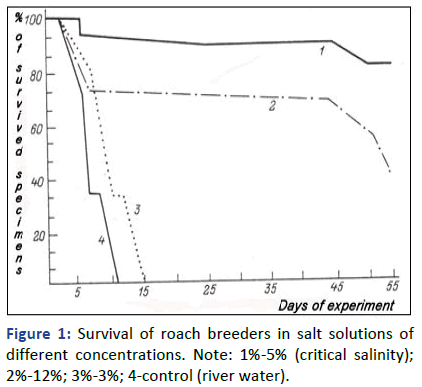
Figure 1: Survival of roach breeders in salt solutions of
different concentrations. Note: 1%-5% (critical salinity);
2%-12%; 3%-3%; 4-control (river water).
Thus it was shown that this critical medium helps fish survival,
providing a bio stimulating effect on the body. The state of the
organism and fish behavior only in 5% solution corresponded
to the original one, which we assess as the normal
physiological state [4]. Total oocyte resorption was observed
almost in all fish in river water (control) to 11 days and in
majority-in solution of 3% to 15 days of detention. Along with
reddening of the skin of the body, most specimens were
covered with sores and are amazed by the saprolegnioz [5].
Contents in blood hemoglobin and total protein, no less than
of 5 animals in each version, were determined to characterize
the general physiological state in experiments.
Results and Discussion
The assessment showed the greatest or high content in the
environment 5% even by the end of the experience and the
smallest (total protein)-already on the 1st day in fresh water
(Table 1).
| Water salinity (experience, %) |
Conditioning period (days of reservation) |
Contents (g %) |
| Hemoglobin |
Total protein |
| 3 |
15 |
 |
 |
| 5 |
45 |
 |
 |
| 12 |
45 |
 |
 |
| Fresh water (control) |
11 |
 |
 |
On the basis of these first results, the experiment on
cultivation of juvenile atlantic salmon production scale in
brackish seawater close to critical salinity was conducted.
Juveniles were grown in cages of hatchery farm pribylovo at
fishing area in the gulf of Finland (vyborg bay) of the Baltic sea
(Figure 2).
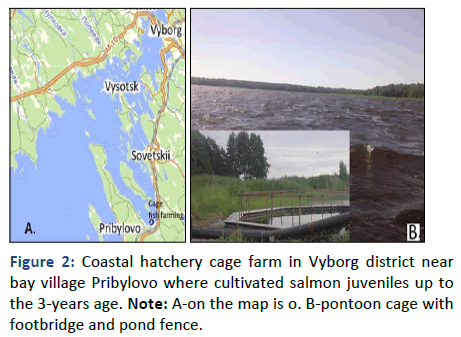
Figure 2: Coastal hatchery cage farm in Vyborg district near
bay village Pribylovo where cultivated salmon juveniles up to
the 3-years age.
Note: A-on the map is o. B-pontoon cage with footbridge and pond fence.
The main targets of growing this economy with total power of
35-40 tons were rainbow trout, Oncorhynchus mykiss and
whitefish, Coregonus muksun [6]. Feeding the fish, including
salmon, party produced experimental fodder company biomar
at the expense of feed-1.4, 1.3 kg [7].
When abnormally hot temperatures (above 20°C, up to 24°C) was set on a high departure as juveniles and
producers, especially vibrioza (Vibrio anguillarum). During
bonitets water temperature averaged 3°C, oxygen
content: 7-8, acidity pH: 8-9. Hydrochemical
indicators average in this area according to the
hydrological stations are shown in Table 2.
| Indicators/biotope |
S (%) |
pH |
Oxygen (mg/L) |
Chlorophyll (mg/L) |
| Surface |
2.01-3.06 |
8.55-9.95 |
7.5-9.47 |
0.2-8.5 |
| Bottom |
2.36-5.45 |
7.8-9.95 |
7.43-10.7 |
0.2-8.6 |
| At the hatchery cages |
2.51 |
8 |
9.11 |
- |
Table 2: Key features of hydrochemical in Vyborg bay according to the hydrological stations (salinity S-own hydrochemical samples).
Pilot batches of young salmon grew up to 1-summer age (0+),
the yearling (1-year-age), 2-summer age (1+), 2-years-age (2),
3-summer age (2+). Total over 3000 specimens grown fish. To
assess the piscicultural and biological and commercial
qualities appraisal conducted reared juveniles [8]. The latter
two age groups (less than 20 individuals) were determined
following piscicultural and biological morphometric indicators:
The length of the head, the length of the snout, eye diameter.
The length of the zaglaznicnogo division head, height of the
head, the width of the forehead, length from the top of the
snout to the dorsal fin, length from the top of the snout to the
anal fin, the length of the grounds of the dorsal fin, maximum
height of the dorsal fin, the
largest height of the anal fin, the length of the anal fin bases, t
he greatest circumference of the body
[9]. Body mass (g) defined as individual weighing and volume-weight
method on a large sample of individuals. Results (raw
data) used in tables that define the coefficient of fatness
(after Fulton) and relative growth, built a histogram
(individually and by age groups) and growth charts. The
results obtained are compared with available reporting (long-term,
decades) of Salmon-Breeding Factory (SBF) Nevskiy data
and standarts on it in the North-west (Leningrad’s) region
[10]. As a result of cultivation and bonitets youngs salmon in
cages by individual weighing and volume-weight methods, it
was found that the mass reached the fingerlings in average 15
g (Table 3).
| |
Age, grams |
| One-summer age: 0+ |
1-year age: 1 |
2-summers age: 1+ |
3-summers age: 2+ |
| Experimental fish farm Pribylovo |
15 |
160 |
280 |
694 |
| Nevsky SBF |
11.3 |
 |
41.6 |
- |
| The standart for region |
5-7 |
9-18 |
20-25 |
- |
Table 3: Average weight of young salmon of different age groups, cultivated in cages Vyborg bay, on Nevskiy SBF and according to regulations.
At the same time, the average mass of yearlings, grown in
Nevskiy SBF amounted to 11.3 g and the same in the
Leningrad region: 5 g-7 g. For comparison, growth dynamics
for SBF fingerlings cultivation amounted during July: from 0.6
g to 2.2 g, by September: 6.9 g, by October: 10 g. Average
weight of yearlings in cages in brackish water has reached 160
g, while in SBF it was 26 g (for multi-year reporting data) [11].
The normative value of this indicator: 9-18, 2010. The average
weight in cages-year-ages stood at 280 g, SBF-41.6 g, at the
norm: 20 g-25 g and finally, the 2-years age smolts in cages in
brackish water reached almost commodity quantity-694 g
[12]. It is important that the compared dynamics of seasonal
changes in temperature in these areas are similar (Figure 3).
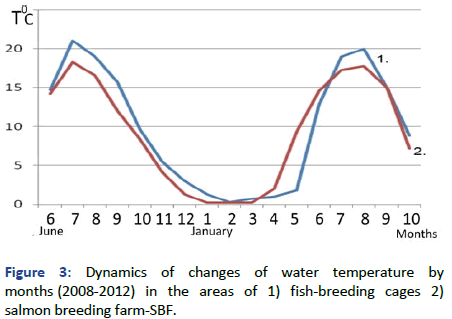
Figure 3: Dynamics of changes of water temperature by
months (2008-2012) in the areas of 1) fish-breeding cages 2)
salmon breeding farm-SBF.
Averaged results of morphometry assessment in fish and
commercial qualities of cultivated juvenile last two age groups
are presented in Table 4.
| Indicators |
Designations |
The average indicators |
| 1+ (2-summer age) |
2+ (3-summer age) |
| The length of the head |
ao |
4.6 ± 0. 19 |
7. 4 ± 0.32 |
| The length of the snout |
an |
1. 8 ± 0. 08 |
2.2 ± 0.17 |
| The diameter of the eye |
np |
1. 26 ± 0. 10 |
1.3 ± 0.11 |
| For the eye division head |
po |
2. 88 ± 0. 14 |
4. 2 ± 0.10 |
| Head height |
lm |
4. 0 ± 0. 17 |
5.38 ± 0.24 |
| The width of the forehead |
oz |
2.01 ± 0.09 |
3. 4 ± 0.19 |
| Body length |
ab |
28.7 ± 3.35 |
39.1 ± 1.55 |
| Body length without caudal fin |
ad |
26.2 ± 1.93 |
35.06 ± 1.50 |
| The maximum height of the body |
gh |
6.42 ± 0.31 |
8.7 ± 0.33 |
| The minimum height of the body |
ik |
2.19 ± 0.17 |
3, 32 ± 0, 26 |
| From the top of the snout to the dorsal fin |
ag |
13.1 ± 0.19 |
15.92 ± 0.35 |
| From the top of the snout to anal fin |
ay |
19.16 ± 0.28 |
25.01 ± 3.42 |
| The dorsal fin base length |
qs |
2.74 ± 0.16 |
4.88 ± 0.16 |
| Overall height of the dorsal fin |
tu |
2.0 ± 0.15 |
2.9 ± 0.21 |
| Max height of the anal fin |
h |
1.82 ± 0.12 |
2.3 ± 0.14 |
| The anal fin base length |
l |
2.6 ± 0.18 |
2.67 ± 0.13 |
| Mass |
m |
280 ± 20.08 |
694.97 ± 96.59 |
Table 4: The average values of morphometric indices-year-ages and trehletok salmon on all parties, grown in cages the Vyborg region.
Based on these bonitet indicators the following comparative
dynamics of growth of young salmon grown in cages in
brackish water and in SBF in river water is provided (Figure 4).
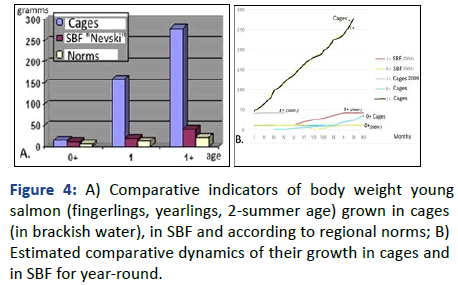
Figure 4: A) Comparative indicators of body weight young
salmon (fingerlings, yearlings, 2-summer age) grown in cages
(in brackish water), in SBF and according to regional norms; B)
Estimated comparative dynamics of their growth in cages and
in SBF for year-round.
Thus, comparison of juvenile mass grown in brackish water
with that in fresh shows a very significant difference
especially in yearlings and 2-summer age. It is important that
the dynamics of seasonal changes in temperature compared
to similar areas [13]. Therefore, increased salinity we may
consider the leading determinant of positive results of
growing juveniles in this environment. A large part of recruits
in SBF already from an early age have starts an asynchronous
process of spontaneous i.e., an unmanaged smoltification that
is associated with an increase in waste and a wide range of
biotechnological difficulties [14]. It is important that such
cultivation and massive appearance of river dwarf males
salmon are also characteristic of factory products. On the
contrary, process of smoltififcation in brackish water is
synchronous and emergence of dwarf males salmon exclude.
Comparison of the characteristics of juvenile mass grown in
cages in brackish water with that in SBF shows very significant
differences especially in the age of yearlings and two year
age-to 5x-7x.
With a view to optimize processes of smoltifikacii and growth
of juvenile farmed-fish 2 directions to improve biotechnology
growing juveniles were proposed to combine. However, if the
use of the new synthetic fodder, feeding regimes,
biostimulants, etc. Reinforce the degree of adaptability of
juveniles to life in the natural environment, then it applies the
method of accelerated development and growth of juvenile
fish in the ecological and physiological against optimum
complex conditions (Figure 5).
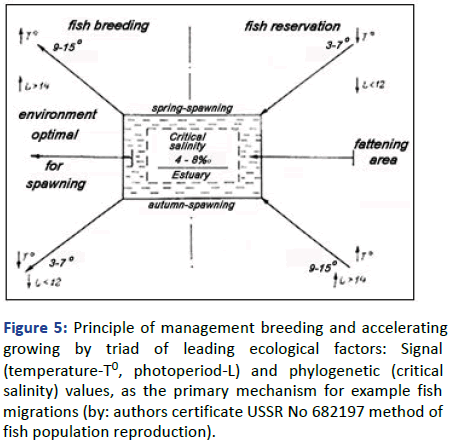
Figure 5: Principle of management breeding and accelerating
growing by triad of leading ecological factors: Signal
(temperature-T0, photoperiod-L) and phylogenetic (critical
salinity) values, as the primary mechanism for example fish
migrations (by: authors certificate USSR No 682197 method of
fish population reproduction).
The main factor is the critical salinity in this triad complex of
environmental factors of signal and phylogenetic significance,
reflecting the underlying mechanism of migrations of
anadromous fish [15]. These factors determine seasonal
physiological cycles and physiological balance of the organism
to the environment-critical salinity. In nature this medium
provides vital physiological mechanism-pre-adaptation
migrant juveniles and manufacturers to move into new
habitats.
Conclusion
In general, the effects of brackish sea water (12%) on growth
and survival of game fish has long attracted the attention of
researchers and fish farmers. In Russia professor suvorov for
the first time raised the possibility of hidden features of
growth of fish in brackish water and recommended it for use
commercial fish farming, especially salmon-farming. Breeding
of salmon in this environment is widely used abroad, for
example in Japan, Norway, USA, Scotland, Denmark etc. Effect
of increasing the survival rate of juveniles, feed assimilation
with and especially the yearling growth set for many other
species and it is also used during their transportation. It can be
concluded that completed innovations of complex
physiological (biostimulati ng, eustress) effects of the impact of this environment on fish breeding and reproduction is
especially important for aquaculture development.
References
- Handeland SO, Berge A, Bjornsson BT, Stefansson SO (1998) Effects of temperature and salinity on osmoregulation and growth of Atlantic salmon (Salmo salar L.) smolts in seawater. Aquaculture. 168(1-4):289-302.
[Crossref] [Google Scholar]
- McCormick SD, Regish AM (2018) Effects of ocean acidification on salinity tolerance and seawater growth of Atlantic salmon Salmo salar smolts. J Fish Biol. 93(3):560-566.
[Crossref] [Google Scholar] [PubMed]
- Imsland AK, Vage KA, Handeland SO, Stefansson SO (2011) Growth and osmoregulation in Atlantic salmon (Salmo salar) smolts in response to different feeding frequencies and salinities. Aquac Res. 42(4):469-479.
[Crossref] [Google Scholar]
- Fjelldal PG, Lock EJ, Grotmol S, Totland GK, Nordgarden U, et al. (2006) Impact of smolt production strategy on vertebral growth and mineralisation during smoltification and the early seawater phase in Atlantic salmon (Salmo salar L.). Aquac. 261(2):715-728.
[Crossref] [Google Scholar]
- Hines CW, Fang Y, Chan VK, Stiller KT, Brauner CJ, et al. (2019) The effect of salinity and photoperiod on thermal tolerance of Atlantic and coho salmon reared from smolt to adult in recirculating aquaculture systems. Comp Biochem Physiol Part A Mol Integr Physiol. 230:1-6.
[Crossref] [Google Scholar] [PubMed]
- Vargas-Chacoff L, Regish AM, Weinstock A, McCormick SD (2018) Effects of elevated temperature on osmoregulation and stress responses in Atlantic salmon Salmo salar smolts in fresh water and seawater. J Fish Biol. 93(3):550-559.
[Crossref] [Google Scholar] [PubMed]
- Stefansson SO, Hansen TJ, Taranger GL (1993) Growth and parr-smolt transformation of Atlantic salmon (Salmo salar L.) under different light intensities and subsequent survival and growth in seawater. Aquac Eng. 12(4):231-243.
[Crossref] [Google Scholar]
- Saunders RL, Harmon PR, Knox DE (1994) Smolt development and subsequent sexual maturity in previously mature male Atlantic salmon (Salmo salar). Aquaculture. 121(1-3):79-93.
[Crossref] [Google Scholar]
- Staurnes M, Sigholt T, Asgard T, Baeverfjord G (2001) Effects of a temperature shift on seawater challenge test performance in Atlantic salmon (Salmo salar) smolt. Aquac. 201(1-2):153-159.
[Crossref] [Google Scholar]
- Prunet P, Boeuf G, Bolton JP, Young G (1989) Smoltification and seawater adaptation in Atlantic salmon (Salmo salar): Plasma prolactin, growth hormone and thyroid hormones. Gen Comp Endocrinol. 74(3):355-364.
[Crossref] [Google Scholar] [PubMed]
- Deane EE, Woo NY (2009) Modulation of fish growth hormone levels by salinity, temperature, pollutants and aquaculture related stress: A review. Rev Fish Biol Fisher. 19:97-120.
[Crossref] [Google Scholar]
- Lysfjord G, Jobling M, Solberg C (2004) Atlantic salmon, Salmo salar L., smolt production strategy affects body composition and early seawater growth. Aquac. 1(237):191-205.
[Crossref] [Google Scholar]
- Fivelstad S, Olsen AB, Asgard T, Baeverfjord G, Rasmussen T, et al. (2003) Long-term sublethal effects of carbon dioxide on Atlantic salmon smolts (Salmo salar L.): Ion regulation, haematology, element composition, nephrocalcinosis and growth parameters. Aquac. 215(1-4):301-319.
[Crossref] [Google Scholar]
- de Fonseka R, Fjelldal PG, Sambraus F, Nilsen TO, Remo SC, et al. (2022) Triploidy leads to a mismatch of smoltification biomarkers in the gill and differences in the optimal salinity for post-smolt growth in Atlantic salmon. Aquaculture. 546:737350.
[Crossref] [Google Scholar]
- Boeuf G, Payan P (2001) How should salinity influence fish growth. Comp Biochem Physiol Part C Toxicol Pharmacol. 130(4):411-423.
[Crossref] [Google Scholar]
Citation: Garlov PE, Bugrimov BS, Rybalova NB (2023) Growing Results of Baltic Salmon Smolts in Sea Water of Critical Salinity. J Veterinary Med 7: 012.
Copyright: © 2023 Garlov PE, et al. This is an open-access article distributed under the terms of the Creative Commons Attribution License, which permits unrestricted use, distribution, and reproduction in any medium, provided the original author and source are credited.















